Abstract
1. Eighteen kittens were monocularly deprived of vision until the age of 5, 6 or 7 weeks. Their eyes were then reverse-sutured, and they were allowed to survive for 3-63 days, before physiological recording from area 17. 2. At the time the reverse-suture was performed, and immediately before the recording session, each kitten was tested separately in the two eyes to elicit five simple behavioural responses: optokinetic nystagmus, visual startle reaction, visually-guided paw placing, visual following and negotiation of a "visual cliff". 3. Following the opening of their initially deprived eye, all kittens appeared behaviourally blind when forced to use that eye; their performance through the initially open eye was then perfect on all tests. After the period of reversed lid-suture, however, their performance when using the initially deprived eye had improved, while that through the initially open eye deteriorated. This complementary improvement and deterioration was most rapid in kittens reverse-sutured at the age of 5 weeks, and less rapid when reverse-suturing was delayed until the age of 6 or 7 weeks. 4. Most of the kittens showed gross abnormalities of interocular alignment, and exhibited marked exotropia or esotropia. 5. The results of these tests were well correlated with the changes seen in cortical ocular dominance in the same animals.
Full text
PDF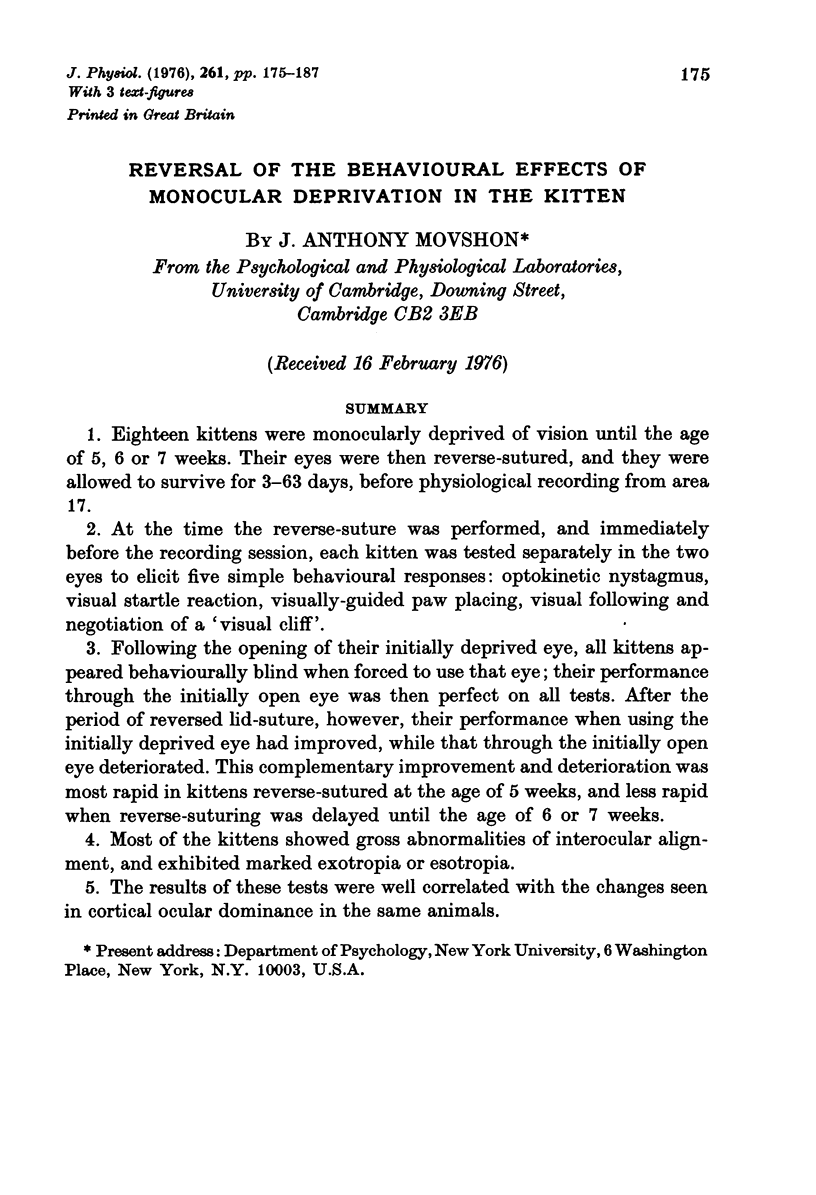
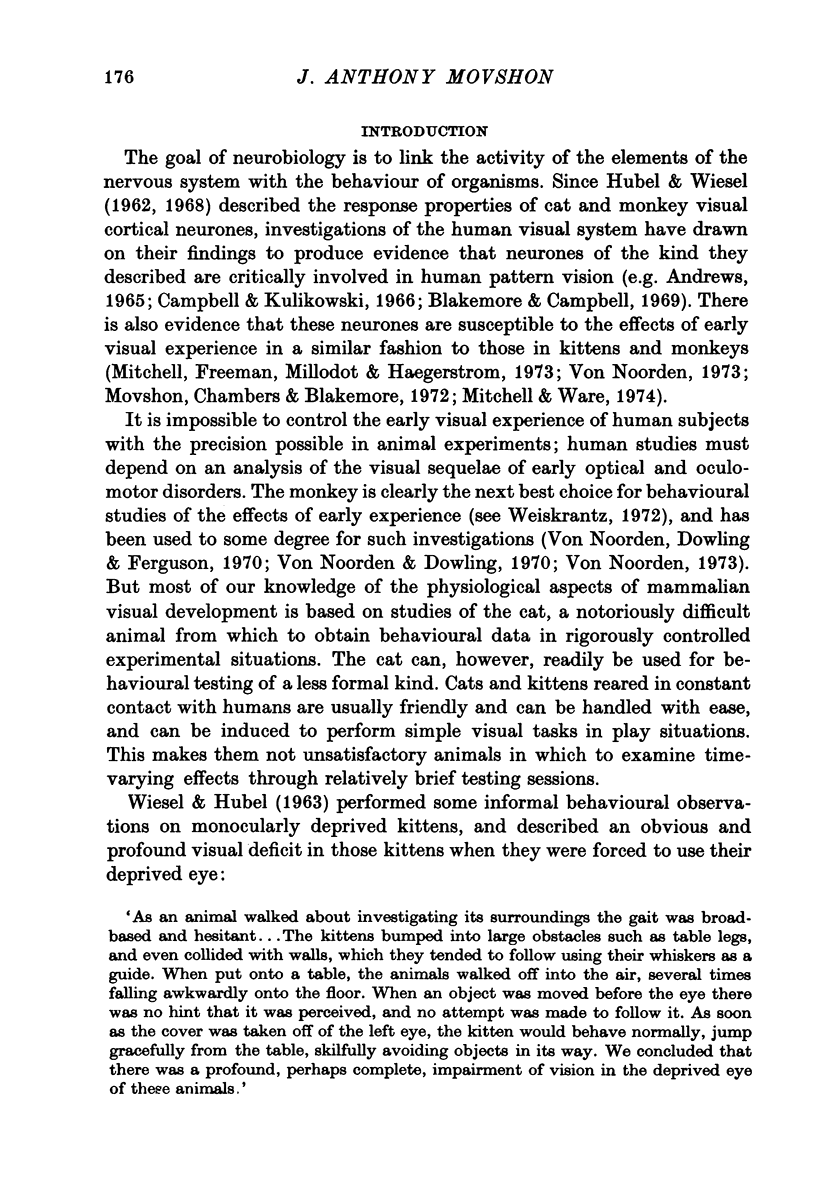
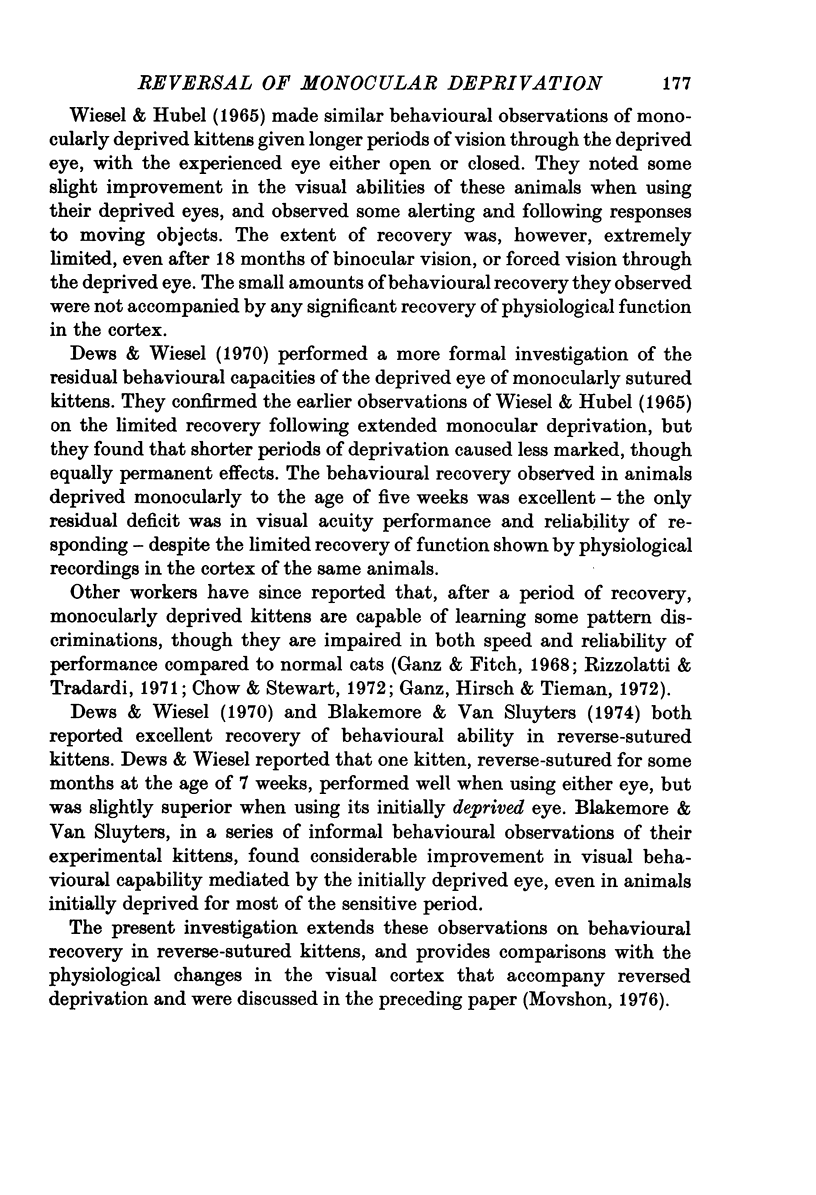
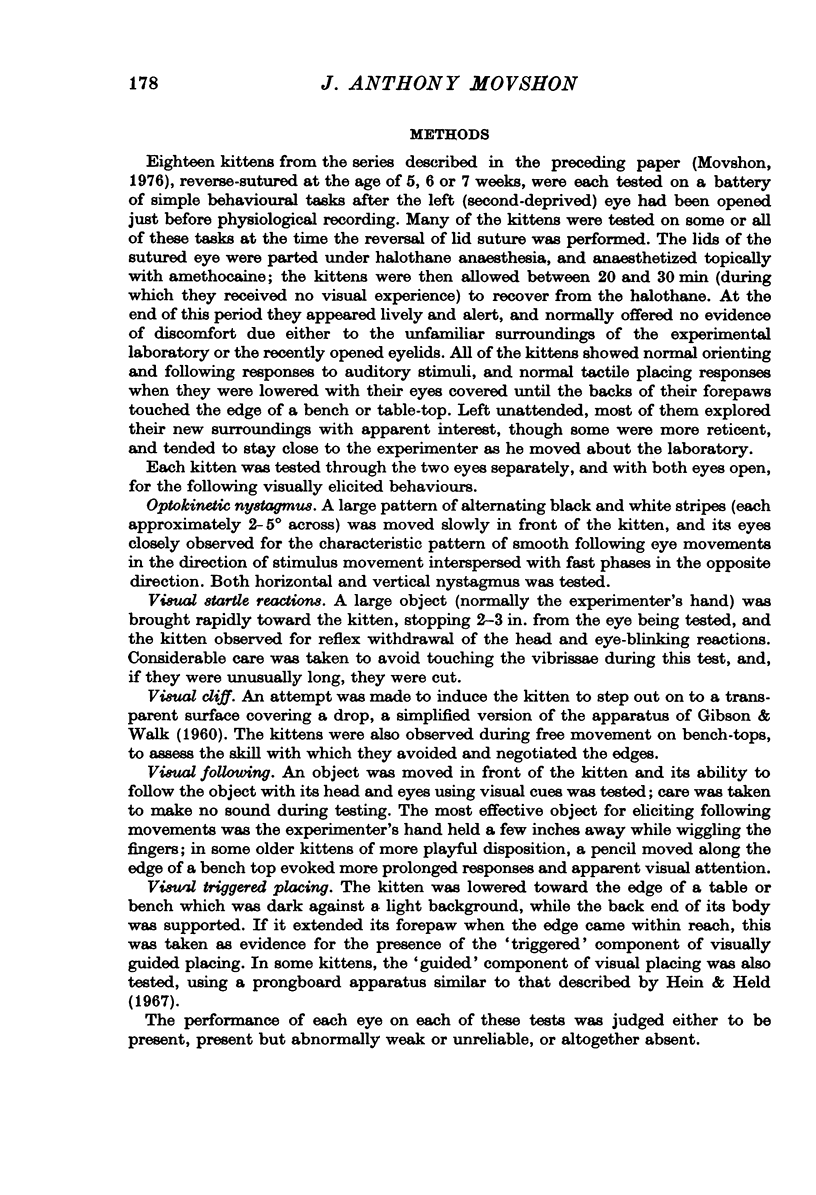
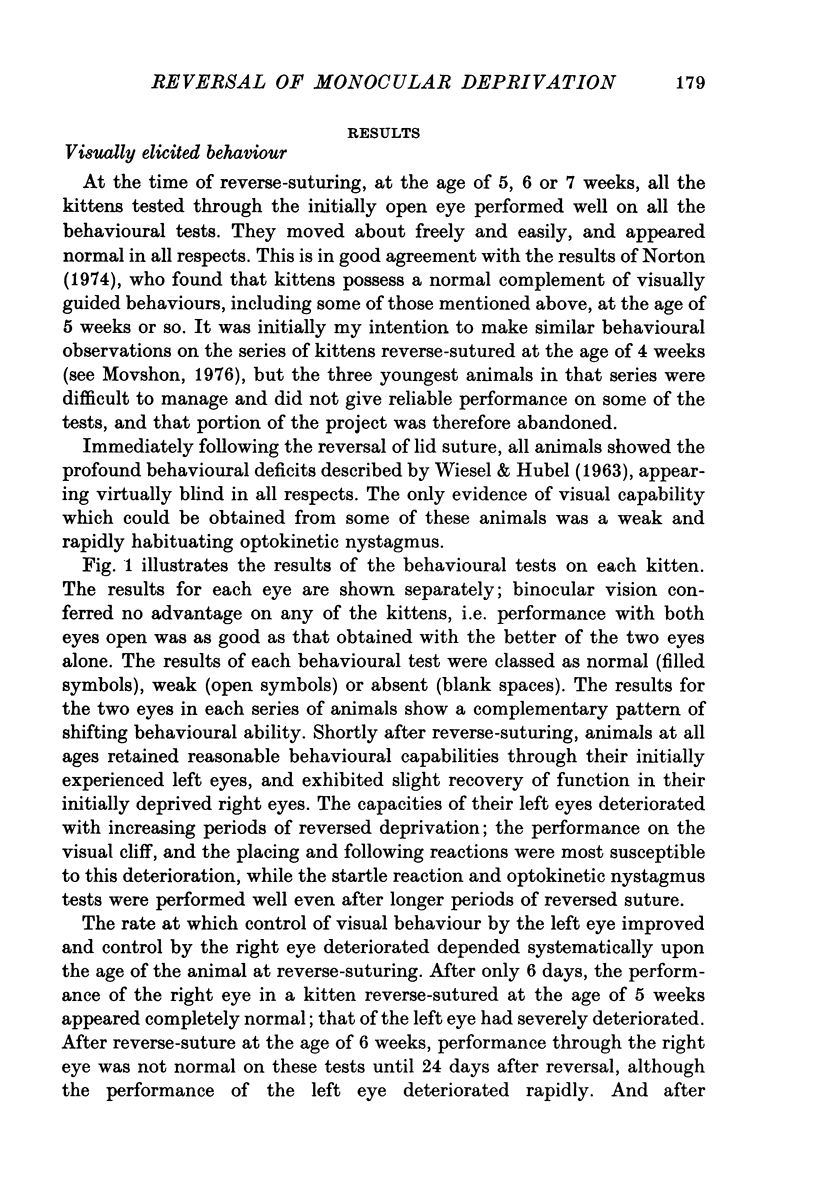
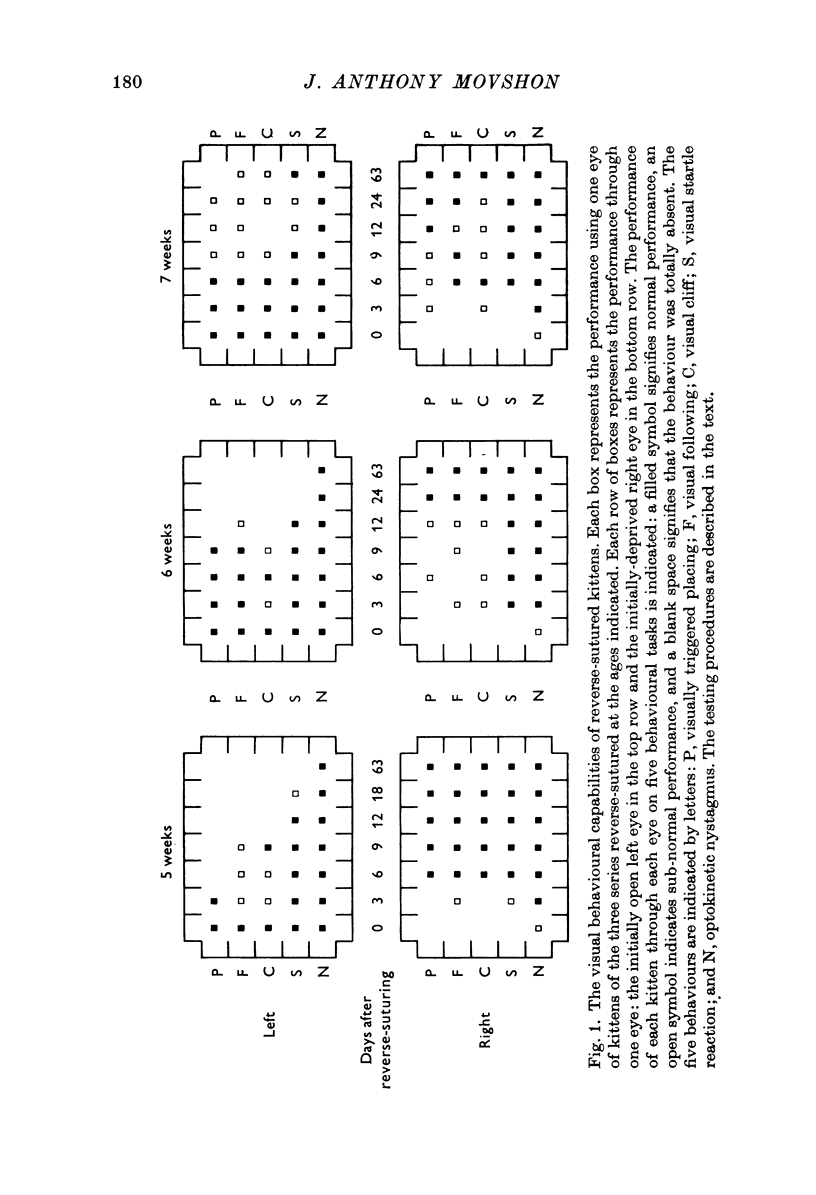
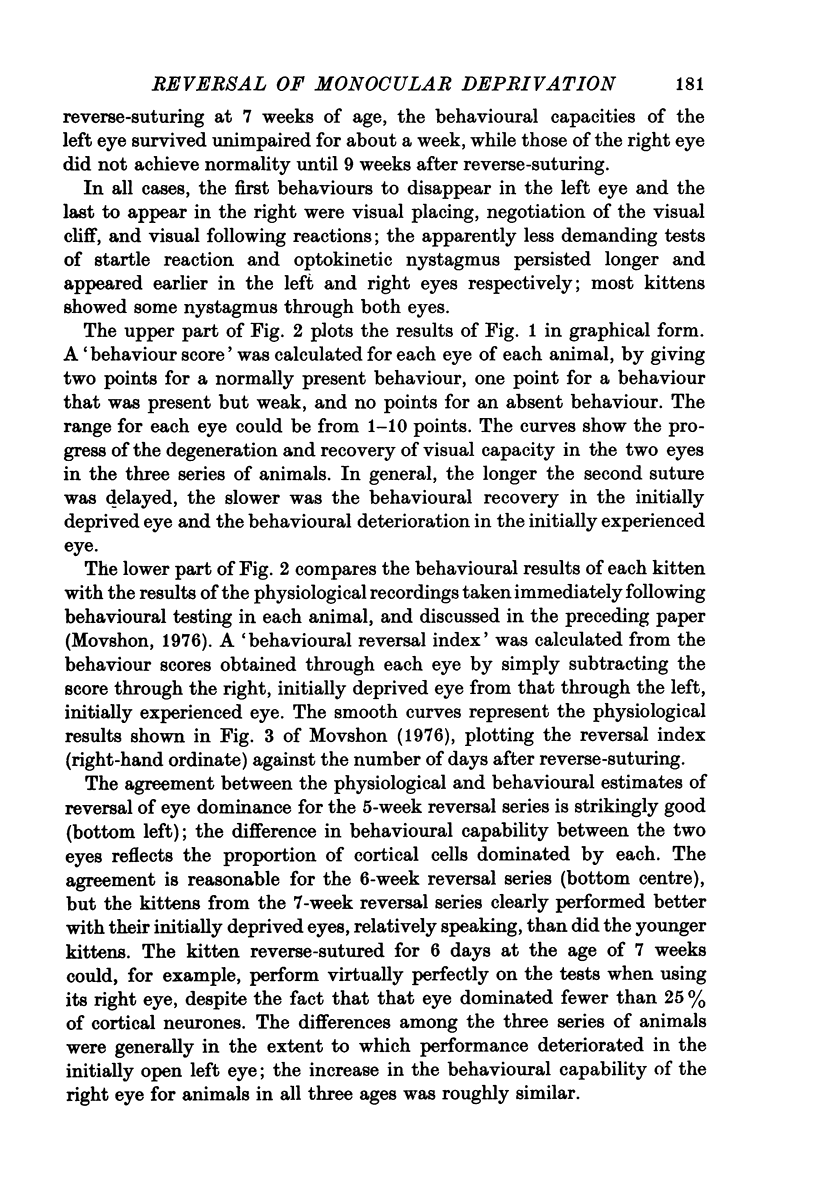

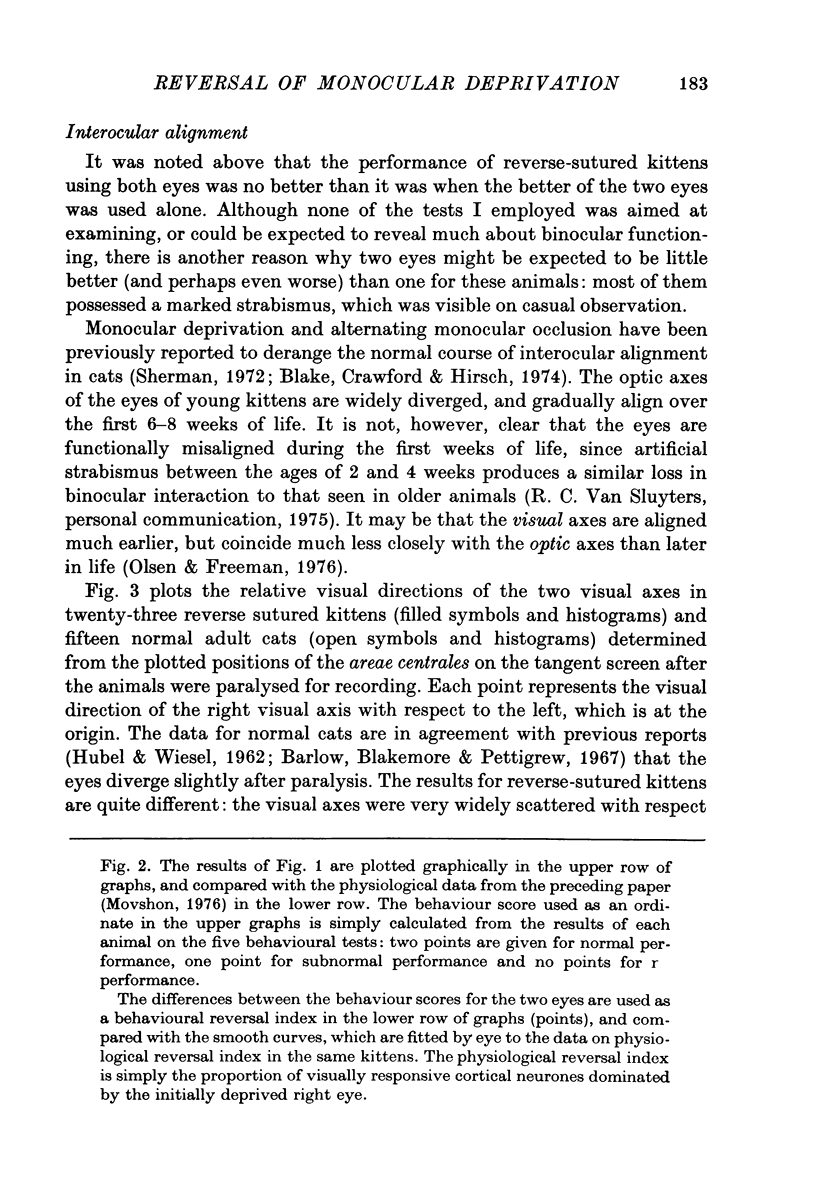
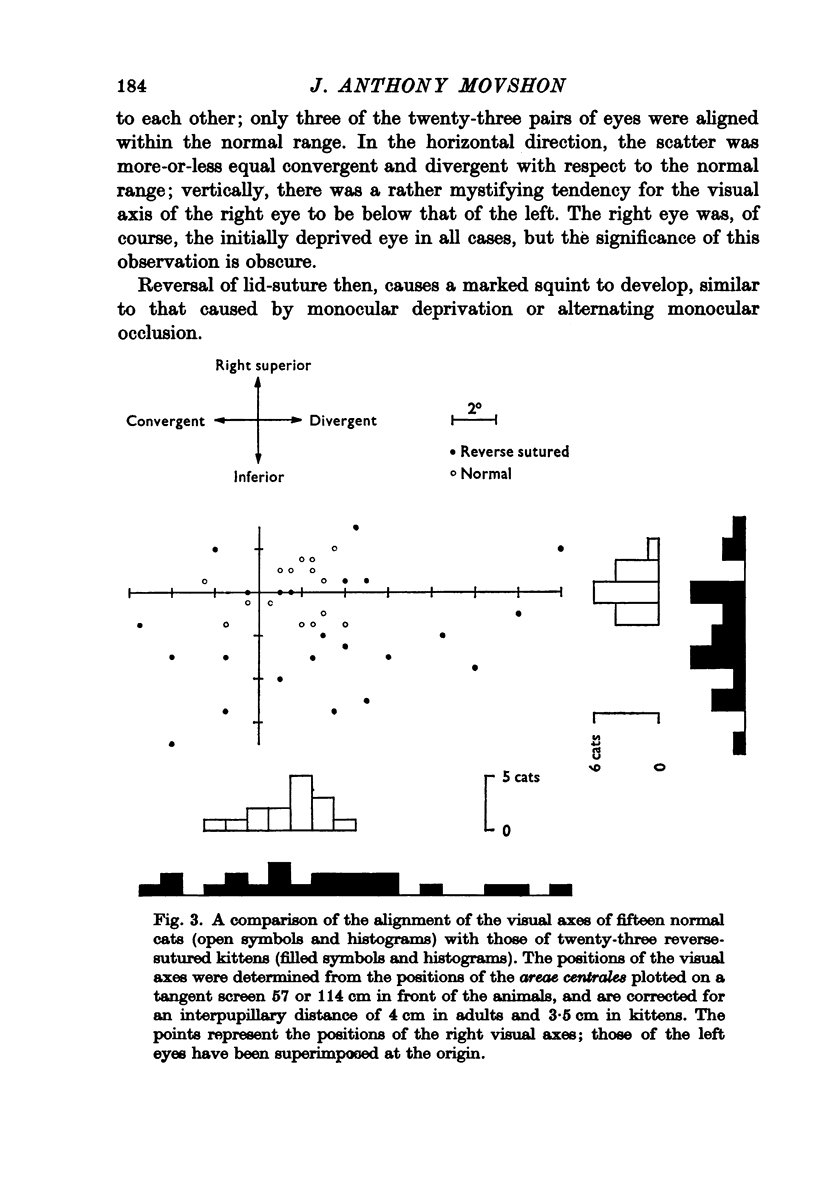
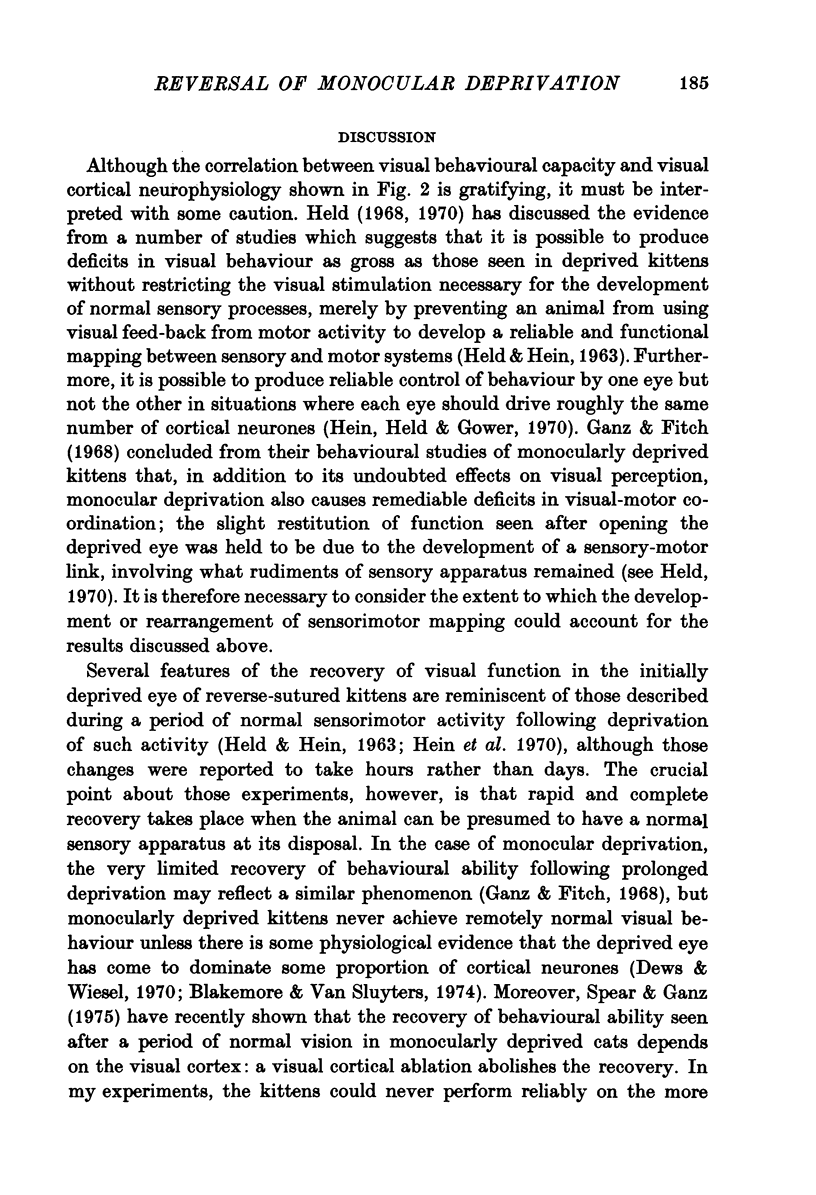
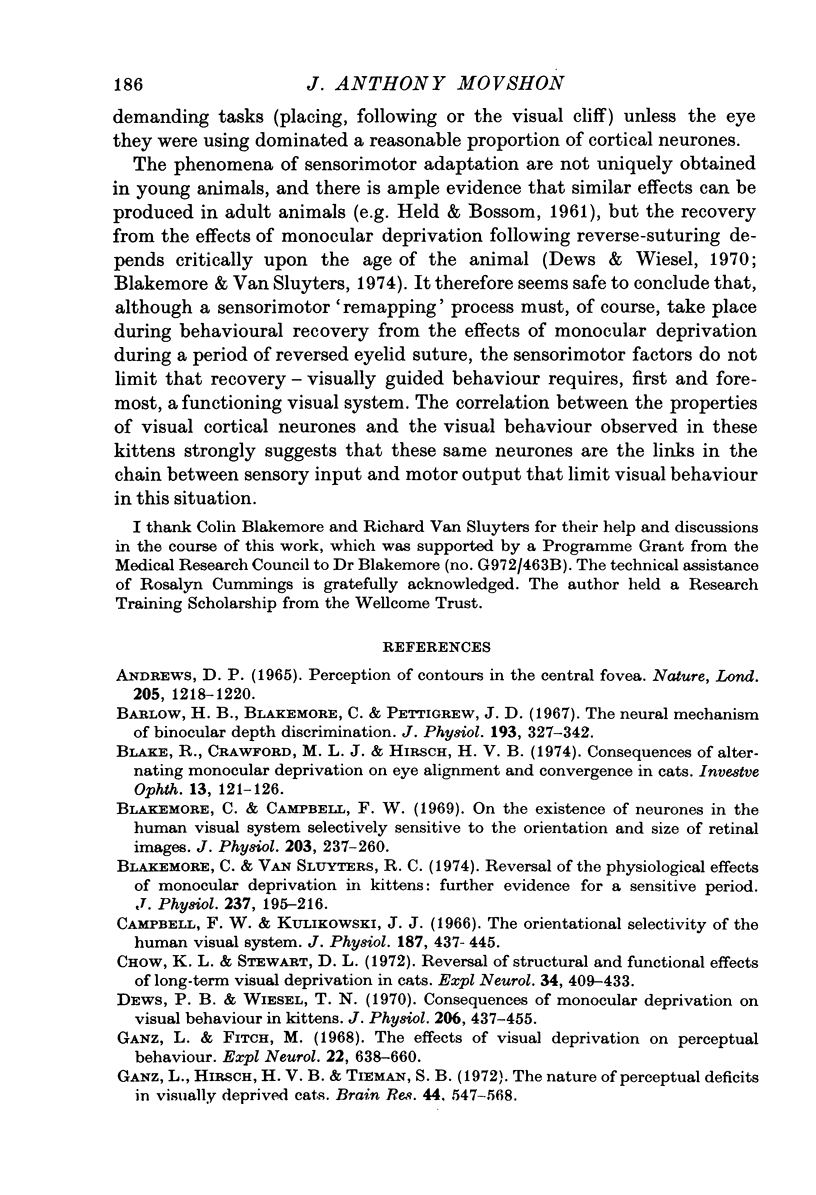
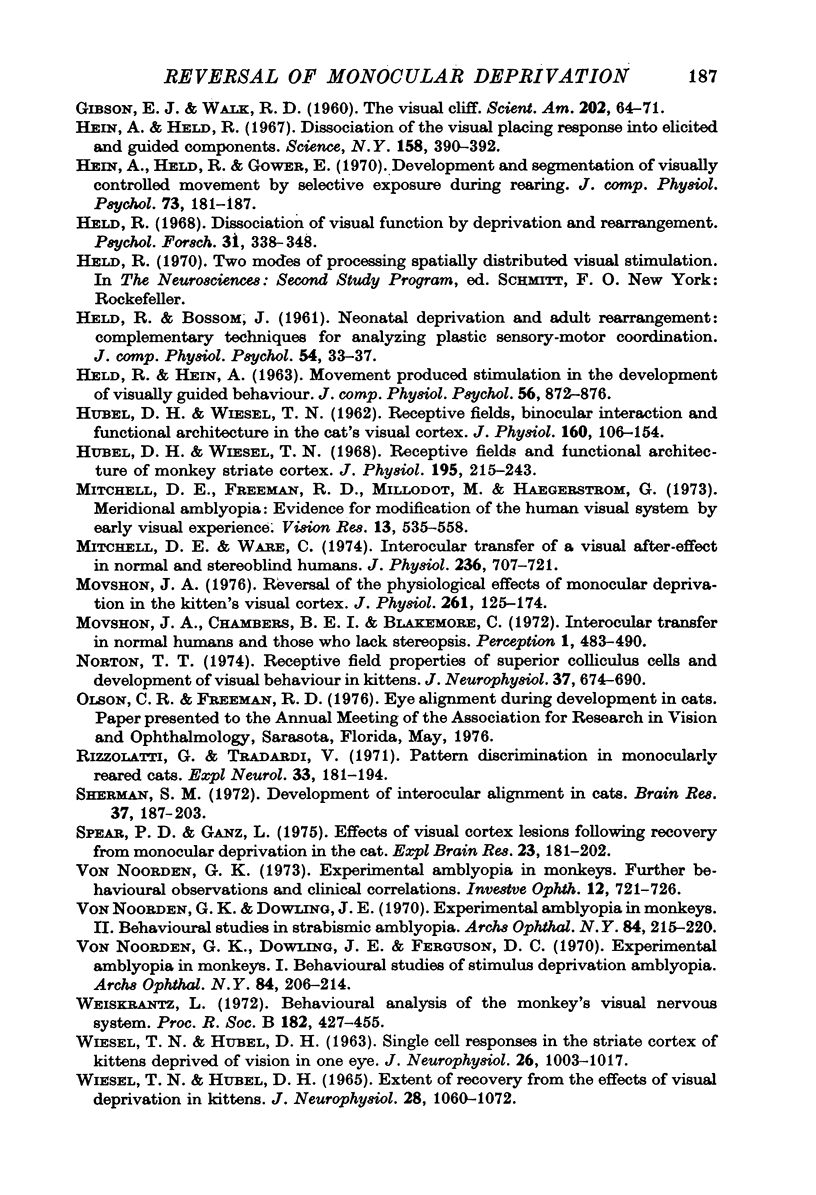
Selected References
These references are in PubMed. This may not be the complete list of references from this article.
- Barlow H. B., Blakemore C., Pettigrew J. D. The neural mechanism of binocular depth discrimination. J Physiol. 1967 Nov;193(2):327–342. doi: 10.1113/jphysiol.1967.sp008360. [DOI] [PMC free article] [PubMed] [Google Scholar]
- Blake R., Crawford M. L., Hirsch H. V. Consequences of alternating monocular deprivation on eye alignment and convergence in cats. Invest Ophthalmol. 1974 Feb;13(2):121–126. [PubMed] [Google Scholar]
- Blakemore C., Campbell F. W. On the existence of neurones in the human visual system selectively sensitive to the orientation and size of retinal images. J Physiol. 1969 Jul;203(1):237–260. doi: 10.1113/jphysiol.1969.sp008862. [DOI] [PMC free article] [PubMed] [Google Scholar]
- Blakemore C., Van Sluyters R. C. Reversal of the physiological effects of monocular deprivation in kittens: further evidence for a sensitive period. J Physiol. 1974 Feb;237(1):195–216. doi: 10.1113/jphysiol.1974.sp010478. [DOI] [PMC free article] [PubMed] [Google Scholar]
- Campbell F. W., Kulikowski J. J. Orientational selectivity of the human visual system. J Physiol. 1966 Nov;187(2):437–445. doi: 10.1113/jphysiol.1966.sp008101. [DOI] [PMC free article] [PubMed] [Google Scholar]
- Chow K. L., Stewart D. L. Reversal of structural and functional effects of long-term visual deprivation in cats. Exp Neurol. 1972 Mar;34(3):409–433. doi: 10.1016/0014-4886(72)90038-6. [DOI] [PubMed] [Google Scholar]
- Dews P. B., Wiesel T. N. Consequences of monocular deprivation on visual behaviour in kittens. J Physiol. 1970 Feb;206(2):437–455. doi: 10.1113/jphysiol.1970.sp009023. [DOI] [PMC free article] [PubMed] [Google Scholar]
- GIBSON E. J., WALK R. D. The "visual cliff". Sci Am. 1960 Apr;202:64–71. [PubMed] [Google Scholar]
- Ganz L., Fitch M. The effect of visual deprivation on perceptual behavior. Exp Neurol. 1968 Dec;22(4):638–660. doi: 10.1016/0014-4886(68)90154-4. [DOI] [PubMed] [Google Scholar]
- Ganz L., Hirsch H. V., Tieman S. B. The nature of perceptual deficits in visually deprived cats. Brain Res. 1972 Sep 29;44(2):547–568. doi: 10.1016/0006-8993(72)90318-6. [DOI] [PubMed] [Google Scholar]
- HELD R., BOSSOM J. Neonatal deprivation and adult rearrangement: complementary techniques for analyzing plastic sensory-motor coordinations. J Comp Physiol Psychol. 1961 Feb;54:33–37. doi: 10.1037/h0046207. [DOI] [PubMed] [Google Scholar]
- HELD R., HEIN A. MOVEMENT-PRODUCED STIMULATION IN THE DEVELOPMENT OF VISUALLY GUIDED BEHAVIOR. J Comp Physiol Psychol. 1963 Oct;56:872–876. doi: 10.1037/h0040546. [DOI] [PubMed] [Google Scholar]
- HUBEL D. H., WIESEL T. N. Receptive fields, binocular interaction and functional architecture in the cat's visual cortex. J Physiol. 1962 Jan;160:106–154. doi: 10.1113/jphysiol.1962.sp006837. [DOI] [PMC free article] [PubMed] [Google Scholar]
- Hein A., Held R. Dissociation of the visual placing response into elicited and guided components. Science. 1967 Oct 20;158(3799):390–392. doi: 10.1126/science.158.3799.390. [DOI] [PubMed] [Google Scholar]
- Hein A., Held R., Gower E. C. Development and segmentation of visually controlled movement by selective exposure during rearing. J Comp Physiol Psychol. 1970 Nov;73(2):181–187. doi: 10.1037/h0030247. [DOI] [PubMed] [Google Scholar]
- Hubel D. H., Wiesel T. N. Receptive fields and functional architecture of monkey striate cortex. J Physiol. 1968 Mar;195(1):215–243. doi: 10.1113/jphysiol.1968.sp008455. [DOI] [PMC free article] [PubMed] [Google Scholar]
- Mitchell D. E., Freeman R. D., Millodot M., Haegerstrom G. Meridional amblyopia: evidence for modification of the human visual system by early visual experience. Vision Res. 1973 Mar;13(3):535–558. doi: 10.1016/0042-6989(73)90023-0. [DOI] [PubMed] [Google Scholar]
- Mitchell D. E., Ware C. Interocular transfer of a visual after-effect in normal and stereoblind humans. J Physiol. 1974 Feb;236(3):707–721. doi: 10.1113/jphysiol.1974.sp010461. [DOI] [PMC free article] [PubMed] [Google Scholar]
- Movshon J. A., Chambers B. E., Blakemore C. Interocular transfer in normal humans, and those who lack stereopsis. Perception. 1972;1(4):483–490. doi: 10.1068/p010483. [DOI] [PubMed] [Google Scholar]
- Movshon J. A. Reversal of the physiological effects of monocular deprivation in the kitten's visual cortex. J Physiol. 1976 Sep;261(1):125–174. doi: 10.1113/jphysiol.1976.sp011551. [DOI] [PMC free article] [PubMed] [Google Scholar]
- Norton T. T. Receptive-field properties of superior colliculus cells and development of visual behavior in kittens. J Neurophysiol. 1974 Jul;37(4):674–690. doi: 10.1152/jn.1974.37.4.674. [DOI] [PubMed] [Google Scholar]
- Rizzolatti G., Tradardi V. Pattern discrimination in monocularly reared cats. Exp Neurol. 1971 Oct;33(1):181–194. doi: 10.1016/0014-4886(71)90112-9. [DOI] [PubMed] [Google Scholar]
- Sherman S. M. Development of interocular alignment in cats. Brain Res. 1972 Feb 25;37(2):187–203. doi: 10.1016/0006-8993(72)90666-x. [DOI] [PubMed] [Google Scholar]
- Spear P. D., Ganz L. Effects of visual cortex lesions following recovery from monocular deprivation in the cat. Exp Brain Res. 1975 Aug 14;23(2):181–201. doi: 10.1007/BF00235460. [DOI] [PubMed] [Google Scholar]
- Von Noorden G. K., Dowling J. E. Experimental amblyopia in monkeys. II. Behavioral studies in strabismic amblyopia. Arch Ophthalmol. 1970 Aug;84(2):215–220. doi: 10.1001/archopht.1970.00990040217015. [DOI] [PubMed] [Google Scholar]
- Von Noorden G. K., Dowling J. E., Ferguson D. C. Experimental amblyopia in monkeys. I. Behavioral studies of stimulus deprivation amblyopia. Arch Ophthalmol. 1970 Aug;84(2):206–214. doi: 10.1001/archopht.1970.00990040208014. [DOI] [PubMed] [Google Scholar]
- WIESEL T. N., HUBEL D. H. SINGLE-CELL RESPONSES IN STRIATE CORTEX OF KITTENS DEPRIVED OF VISION IN ONE EYE. J Neurophysiol. 1963 Nov;26:1003–1017. doi: 10.1152/jn.1963.26.6.1003. [DOI] [PubMed] [Google Scholar]
- Wiesel T. N., Hubel D. H. Extent of recovery from the effects of visual deprivation in kittens. J Neurophysiol. 1965 Nov;28(6):1060–1072. doi: 10.1152/jn.1965.28.6.1060. [DOI] [PubMed] [Google Scholar]
- von Noorden G. K. Experimental amblyopia in monkeys. Further behavioral observations and clinical correlations. Invest Ophthalmol. 1973 Oct;12(10):721–726. [PubMed] [Google Scholar]


